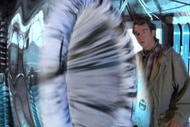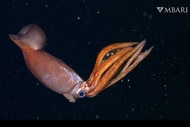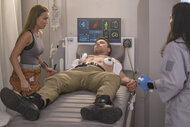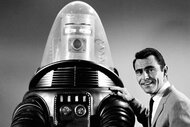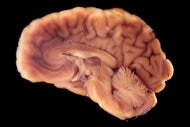Create a free profile to get unlimited access to exclusive videos, sweepstakes, and more!
Cyborg zebrafish has swimming muscles made of beating human heart cells
A fish full of heart, just in time for Valentine's Day!

In fiction, cyborgs typically start as fully biological and later have mechanical elements incorporated. This has the convenient consequences of avoiding questions of whether or not a cyborg is a living thing. The recent creation of a biohybrid fish, modeled after a zebrafish and crafted in part out of human heart cells, blurs the lines around what it means to be alive.
Kevin Kit Parker, from Harvard Stem Cell Institute at Harvard University, and colleagues, have constructed a series of partially biological machines modeled after marine organisms in an attempt to better understand the inner workings of the heart. Their latest creation looks and moves like a zebrafish, while being constructed of paper, gelatin, and human heart cells. The results of their work were recently published in the journal Science.
“The really interesting philosophical thing about the fish is morphologically and functionally, it’s a fish, but genetically it’s human. It’s alive, but it’s not a life form,” Parker told SYFY WIRE.
Parker first got the idea for these biohybrid machines while on a trip to the New England aquarium with his daughter. Looking at the jellyfish, pumping and swimming in their enclosure, Parker realized he could probably build something similar. In 2012, using heart cells from rats, Parker and team did just that. Four years later they built a stingray, again using rat cells. This time around they shifted to human heart cells.
“What I came to realize over the course of that field trip was that with the exception of crustaceans, every marine lifeform, almost all of their musculature is designed to pump. The idea was, what if we take heart muscle cells and the biophysics of the heart, could we replicate these fish and their swimming?” Parker said.
Zebrafish have two layers of muscle on each side of their bodies, which they use to maneuver through the water. One side contracts while the other stretches, this lets the tail pull to one side or the other. Then the priorities switch and you see the body swing the other way. The muscular relationship is similar to the way your biceps and triceps either contract or relax when curling or extending your arm. It’s also the way the heart works.
“In the cardiac cycle you have systole when the ventricles are squeezing, and diastole where the ventricles are resting. Many people believe they’re passively filling with blood, we believe the heart is actually sucking, which means some part of the heart is contracting,” Parker said.
Borrowing from the biophysical processes of the human heart, the team layered heart cells along the relevant parts of its fishy shape and set them pumping at alternating intervals to mimic the back-and-forth motions of a fish’s tail.
The motion happens completely autonomously, without the need of any external signaling. At the top of the tissue, the fish has what’s known as a G-node, a replica of sinoatrial node — the natural pacemaker — of the human heart. The tissue layers were constructed in a way that action at the G-node sends a wave of electrical activity throughout.
“The G-node has an intrinsic tickle in it. That tickle turns into a wave of excitation which propagates through the cardiac tissue to get things going,” Parker said.
Once that occurs, the cycle maintains itself. When one side of the fish stretches, contraction of the other side is triggered, and the fish keeps swimming. In fact, by the end of the experiment the fish had been swimming inside their small enclosures for nearly five months without stopping.
It’s possible they could have kept swimming much longer. These fish don’t eat in the way we would understand it, they don’t even have mouths. Instead, they swim in a container of cell media which includes things like amino acids and glucose, which allows the cells to gather energy from their environment.
Upon publication of the paper, the tiny school of artificial fish were discontinued, and the experiment ended. But Parker and the team have plans for bigger and better things.
“Our next step is to go into three dimensions and look at some more complex marine life forms to see if we can replicate human cardio biophysics into three dimensional pumps,” Parker said.
The ultimate aim of their research is to build a better artificial heart for use in children born with cardiac anomalies. Using cardiac tissues to replicate the pumping structures of marine animals let’s us glimpse at the underlying engineering of the human heart and, with each iteration, we swim a little bit closer to that goal.
